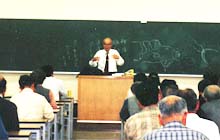COLLEGE OF MISCELLANEOUS STUDIES:
A Creative Effort Led by Citizens
June 29, 1999

The enthusiastic response to classes at the school proves you're never too old to learn.
No tuition charged, no payment made to lecturers, and no fees needed
for borrowing the venue: At one unique citizens' college in the Tama
area of western Tokyo, expenses are almost nil for both students and
administrators. In its fourth year, the college is run entirely by
volunteers. Some 500 students are enrolled, most of whom are in their
sixties, and the number of lecturers totals about 200. The quality
of the lectures, moreover, stands on a par with those given at regular
universities.
Responding to People's Will to Learn
The college was opened in August 1995 by a resident of Hoya City in
Tokyo in response to calls for a center for lifelong learning. At
that time the Tama area (comprising the cities located in the western
part of Tokyo Prefecture, including Hoya) already had a large number
of retired citizens, many of whom possessed a rich intellectual appetite
and wanted to begin studying something anew. These citizens' desire
to learn meshed extremely well with the aim of universities, faced
with a declining number of students, of promoting more interchange with the
community, so the college was inaugurated.
Classes are held every Sunday, with renowned scholars and other persons
of culture as lecturers, and the venue switches among several places
that local universities, post offices, and companies lend for free.
Contrary to what one might imagine from the name Nishi Tokyo Zatsugaku
Daigaku (West Tokyo College of Miscellaneous Studies), the quality
of its class contents is just as high as that of ordinary universities.
The curriculum consists of 13 subjects: politics, economics, Tama
studies, natural science, high-tech industry, environment, literature,
fine arts, education, history, religion, family life, and daily life.
Checks on Public Administration
There is no age limit for enrollment. The college's reputation has
spread by word of mouth, and nowadays there are students who come
from neighboring Kanagawa Prefecture and even more distant Chiba Prefecture.
About 100 students attend each class.
The lecturers evaluate the school highly, too. One professor, for
example, was deeply impressed after giving a lecture. "Young students
at regular colleges often chat during class," he said. "Here, everyone
listens earnestly, and their questions go right to the point." Since
its inception, the college has had no lack of people volunteering
to be lecturers.
Many of the students are former corporate and government employees
who left work at retirement age. Taking advantage of the broad personal
connections brought on by such students and lecturers, the college
organizers are planning to create a think tank in the future to keep
a check on administrative functions and tax money. From lifelong learning
to the surveillance of wide-area administration, the dream keeps on
growing.
 Edited
by Japan Echo Inc. based on domestic Japanese news sources. Articles presented
here are offered for reference purposes and do not necessarily represent
the policy or views of the Japanese Government.
|



















